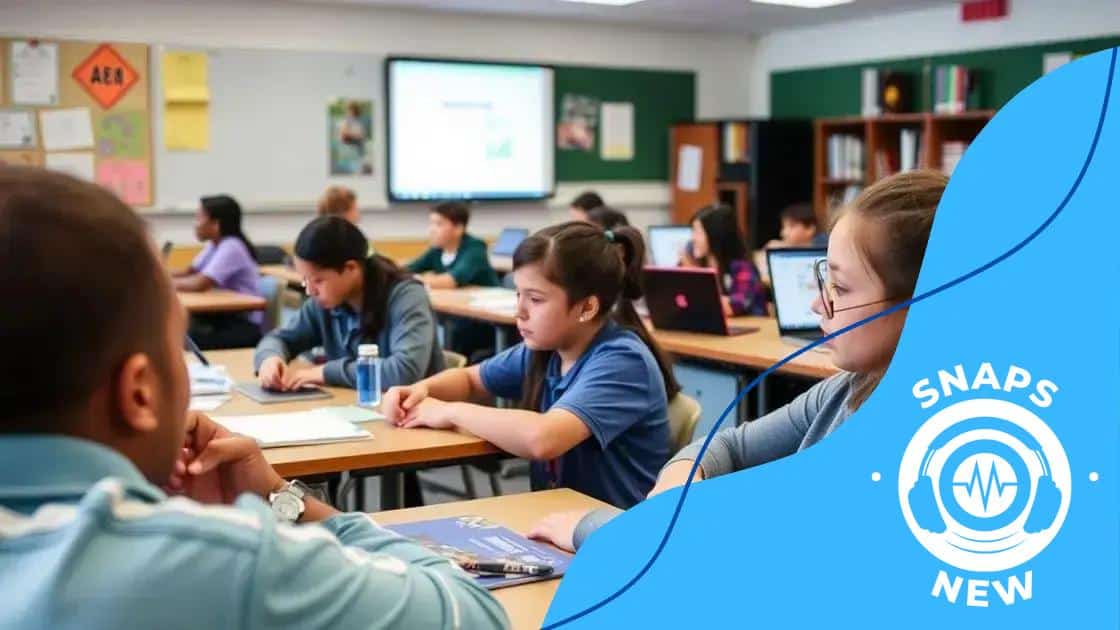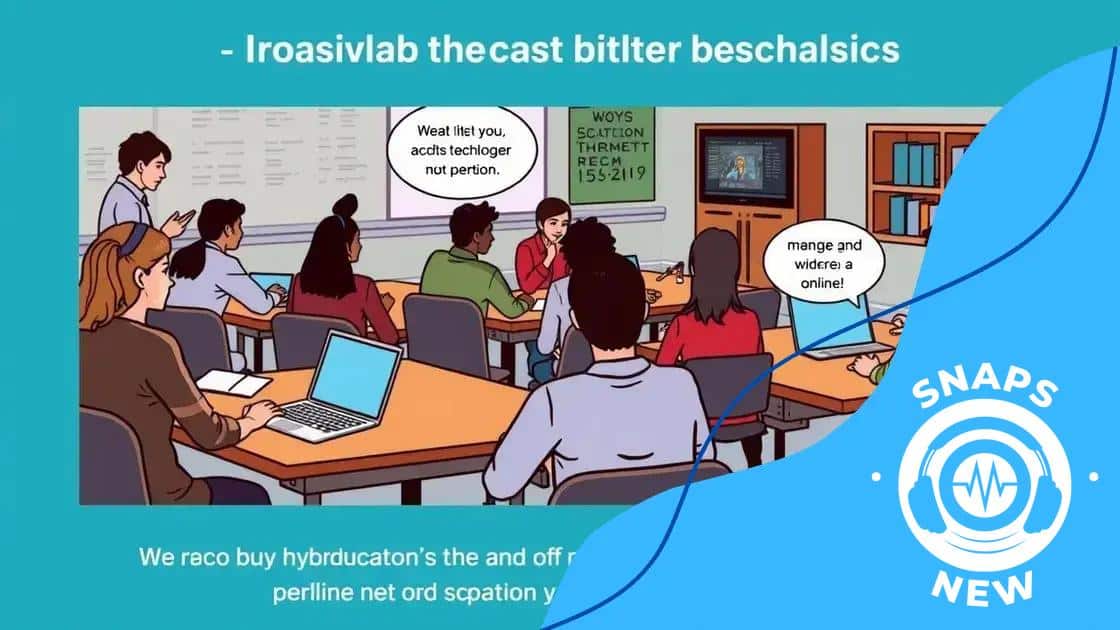Hybrid learning effectiveness: Unlocking student potential

Hybrid learning effectively combines in-person and online education, offering flexibility, increased engagement, and personalized learning experiences to enhance student success.
Hybrid learning effectiveness has emerged as a game-changer in education. This approach combines in-person and online learning, fostering engagement and flexibility. Have you ever wondered how it can transform your learning experience?
Understanding hybrid learning
Understanding hybrid learning is essential in today’s educational landscape. This approach combines both in-person and online education, allowing students to benefit from the advantages of each method. By blending traditional classroom experiences with digital tools, educators can create a more engaging and flexible learning environment.
The Basics of Hybrid Learning
In hybrid learning, students attend classes physically while also accessing materials and activities online. This dual approach can cater to diverse learning styles, ensuring that all students have the chance to succeed.
Key Features of Hybrid Learning
- Flexibility: Students can learn at their own pace.
- Accessibility: Resources are available anytime, anywhere.
- Engagement: Interactive tools enhance participation.
- Personalization: Tailored learning experiences suit individual needs.
The flexibility of hybrid learning allows students to balance their studies with other responsibilities, promoting a healthier educational experience. For instance, an online discussion forum can complement in-class lectures, offering students the opportunity to explore topics more deeply.
Educators can utilize various tools to facilitate hybrid learning. Video conferencing, learning management systems, and even social media can enhance the learning experience. Such tools provide continuous support and resources, making it easier for students to stay engaged and informed.
For successful implementation, schools must train their teachers well in using technology and developing effective teaching strategies in a hybrid environment. Understanding the nuances of hybrid learning empowers educators to create an inclusive and productive atmosphere for all students.
Benefits of hybrid learning
The benefits of hybrid learning are transforming how students engage with their education. This approach not only blends traditional classroom methods with online tools but also caters to various learning styles and needs. By incorporating both formats, students can gain more from their educational experiences.
Enhanced Flexibility
Hybrid learning offers significant flexibility for students. They can learn at their own pace, accessing materials whenever it suits them. This adaptability allows students to manage their time better, balancing education with other responsibilities.
Increased Engagement
With the combination of in-person and online methods, hybrid learning often leads to higher student engagement. Online resources such as videos, quizzes, and interactive discussions keep students actively involved.
- Variety of Learning Tools: This model encourages the use of multiple educational technologies.
- Collaborative Learning: Students can work together both physically and digitally.
- Improved Retention: Engaging content enhances understanding and memory.
- Personalized Instruction: Instructors can tailor lessons to fit different learning styles.
Furthermore, hybrid learning allows for a more personalized educational experience. Teachers can focus on individual student needs, providing targeted support and resources. This individual attention can boost student confidence and academic performance.
Another advantage is that students can interact seamlessly with peers and instructors, even when learning remotely. Online platforms enable real-time communication, fostering a sense of community that may be harder to achieve in a traditional setting. As a result, learners feel more connected and accountable.
Ultimately, the benefits of hybrid learning extend beyond mere convenience. They promote a well-rounded, engaging, and effective educational experience, preparing students for success in a digital world.
Challenges in implementing hybrid education

Implementing hybrid education comes with its own set of challenges. While this approach has many benefits, addressing potential issues is crucial for its success. Schools and educators need to be prepared to tackle these hurdles effectively.
Technology Access and Reliability
One of the major challenges is ensuring all students have access to the necessary technology. Not everyone has a reliable internet connection or appropriate devices. This digital divide can lead to disparities in learning opportunities.
Teacher Training
Another significant obstacle is providing adequate training for teachers. Educators must feel comfortable using various online tools and strategies to facilitate hybrid education. Without proper support, teachers may struggle to engage students effectively.
- Understanding platforms: Teachers need to be proficient with online learning management systems.
- Building online presence: Instructors must develop strong communication skills for virtual classrooms.
- Adapting lesson plans: Lessons should be tailored to blend both in-person and online formats.
Moreover, managing classroom dynamics can be tricky in a hybrid education environment. Teachers must find ways to keep both in-person and remote students engaged simultaneously. This requires creativity and adaptability in lesson delivery.
Furthermore, assessing student performance in a hybrid setting can be complicated. Formative assessments, feedback, and grading practices need to be clearly defined to ensure fairness and accuracy.
In summary, while hybrid education has great potential, schools need to recognize and address these challenges proactively. By equipping educators and students with the right resources and support, they can create an effective and inclusive learning environment.
Strategies for effective hybrid classrooms
Strategies for effective hybrid classrooms are vital for optimizing the learning experience. As education evolves, teachers must adapt their methods to ensure all students thrive, whether they are physically present or attending online.
Clear Communication
One critical strategy is establishing clear communication channels. This includes using platforms where students can ask questions and interact with peers and instructors easily. Regular check-ins and updates foster a sense of community and keep everyone engaged.
Interactive Learning Activities
Creating interactive learning activities is key to an effective hybrid classroom. By involving all students in discussions and collaborative projects, teachers can ensure that everyone feels included.
- Use breakout rooms: For group discussions, utilize virtual breakout rooms to connect online students.
- Incorporate technology: Use quizzes, polls, and educational games to engage learners.
- Encourage peer feedback: Promote a culture of constructive criticism among students.
Another important aspect is integrating technology seamlessly into daily lessons. Teachers should invest time in learning new platforms and tools that can enhance both in-person and online experiences. This not only supports diverse learning styles but also makes learning more engaging.
Furthermore, setting expectations for both in-person and remote participants can enhance the overall effectiveness of a hybrid classroom. Providing guidelines on attendance, participation, and assignments can create a sense of accountability among students.
Finally, regularly seeking feedback from students about the hybrid learning experience is crucial. Understanding what works and what doesn’t helps educators refine their approach to meet the needs of their students better.
Future of hybrid learning
The future of hybrid learning looks promising as educational institutions continue to evolve. As technology advances, the way we teach and learn will likely shift to accommodate new methods that enhance student engagement and understanding.
Integration of Advanced Technology
New technologies will play a crucial role in the evolution of hybrid learning. Virtual reality (VR) and augmented reality (AR) are set to revolutionize the classroom experience. These technologies can create immersive learning environments that allow students to explore complex subjects in engaging ways.
Personalized Learning Experiences
Another significant trend is the movement towards personalized learning. Hybrid learning makes it easier to cater to individual student needs. Using data analytics, teachers can identify strengths and weaknesses, allowing them to tailor lessons better.
- Adaptive Learning Software: Programs that adjust difficulty based on student performance.
- Real-Time Feedback: Utilizing technology to provide instant assessments.
- Flexible Learning Paths: Allowing students to progress at their own pace.
Moreover, as more schools adopt hybrid education, the importance of community and collaboration will grow. Schools will likely engage more with parents and local businesses to create supportive learning environments. Building partnerships can lead to more resources and opportunities for hands-on learning.
Additionally, educators will need ongoing professional development to adapt to these changes effectively. Training programs will focus on equipping teachers with the skills needed to navigate the technology and methodologies required for a successful hybrid learning environment.
As we look ahead, it’s clear that hybrid learning will pave the way for a more equitable and inclusive educational system. It holds the potential to break down barriers, allowing students from diverse backgrounds to thrive in their studies.
In conclusion, hybrid learning is transforming education by combining the best of both in-person and online teaching. This approach offers flexibility, engages students, and personalizes their learning experiences. As we look to the future, technology will continue to evolve, making learning more accessible to everyone. To navigate this shift successfully, schools must prioritize training teachers and fostering a community that supports innovation. By embracing the benefits of hybrid education, we can create a more inclusive and effective learning environment for all students.
FAQ – Frequently Asked Questions about Hybrid Learning
What is hybrid learning?
Hybrid learning combines in-person and online education to enhance the learning experience of students.
What are the benefits of hybrid learning?
Benefits include flexibility, increased engagement, personalized learning experiences, and better technology integration.
What challenges might schools face when implementing hybrid learning?
Schools may encounter issues like technology access, teacher training, managing classroom dynamics, and assessing student performance.
How can technology improve hybrid learning?
Technology enables interactive learning, real-time feedback, and immersive experiences, helping to keep students engaged and motivated.





